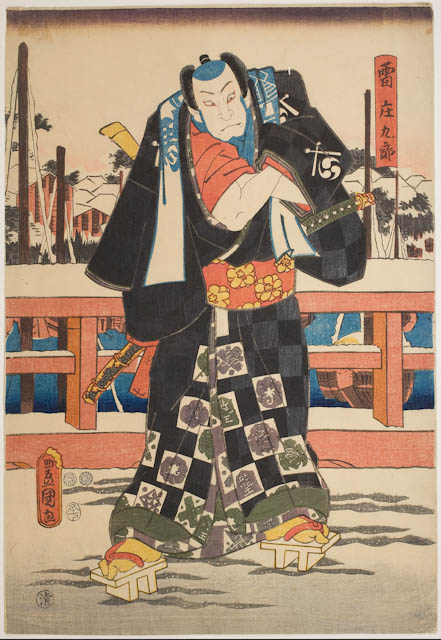| Maker(s): | Utagawa Kunisada I (Toyokuni III) | | Culture: | Japanese (1786-1864)
| | Title: | An actor in the role of Kaminari Shokuro
| | Date Made: | 1852
| | Type: | Print
| | Materials: | Colored ink on paper; woodcut
| | Place Made: | Asia; Japan
| | Measurements: | Mat: 17 15/16 in x 14 5/16 in; 45.6 cm x 36.4 cm; Sheet: 14 11/16 in x 10 1/16 in; 37.3 cm x 25.6 cm; Image: 14 9/16 in x 10 1/16 in; 37 cm x 25.6 cm
| | Narrative Inscription: | SIGNATURE: recto, lwr. l. (black ink in cartouche): [Japanese character, Toyokuni ga]; TITLE: recto, upp. r. (black ink): [Japanese character, Kiminari Shokuro]; SEAL: recto, lwr. l. (black ink): [Japanese character, Fuku]; SEAL: recto, lwr. l. (black ink): [Japanese character, Muramatsu]; SEAL: recto, lwr. l. (black ink): [Japanese character, Ko Ju]; SEAL: recto, lwr. l. (black ink): [Japanese character, Sei].
| | Accession Number: | MH 1962.172.Q.RII
| | Credit Line: | Gift of Mrs. M. W. Thompson
| | Museum Collection: | Mount Holyoke College Art Museum
|
|

|
Description:
Otokodate identified as Kaminari Shokuro stands on a snow covered bridge.
Label Text:
The military class known as the samurai flourished in Japan from the 12th to the 19th century. Though best known in the West as fierce warriors, the samurai were also highly educated elites with political power and cultural influence.
Samurai traditionally wore two swords – one short blade and one long – known together as daisho. An example of a daisho set can be seen to the left, with its lavishly ornamented lacquer dressing box. A samurai would typically wear both swords tucked into his obi (the wide sash encircling the kimono), a style illustrated by the figure in the woodblock print above.
Despite donning the daisho, the figure in this print is not a samurai, but rather an otokodate, or “chivalrous commoner,” named Kaminari Shokuro. The otokodate were outlaws who protected common people against the violent excesses of the samurai. Popular subjects in 19th-century Japanese theater, the otokodate were heroic figures in a time of widespread discontent with the samurai, who had become increasingly violent towards civilians.
The samurai’s power waned steadily in the 19th century, and the class itself was dissolved entirely in the 1870s. The expert swordsmiths who crafted samurai blades and armor were forced to take up other pursuits. The small and intricate cast bronze turtle in this case is an example of the kind of metalwork that these highly skilled artisans turned to after the decline of the samurai class.
(2015)
Tags:
winter; Ukiyo-e; kabuki Subjects:
Kabuki Link to share this object record:
https://museums.fivecolleges.edu/detail.php?t=objects&type=ext&id_number=MH+1962.172.Q.RII |